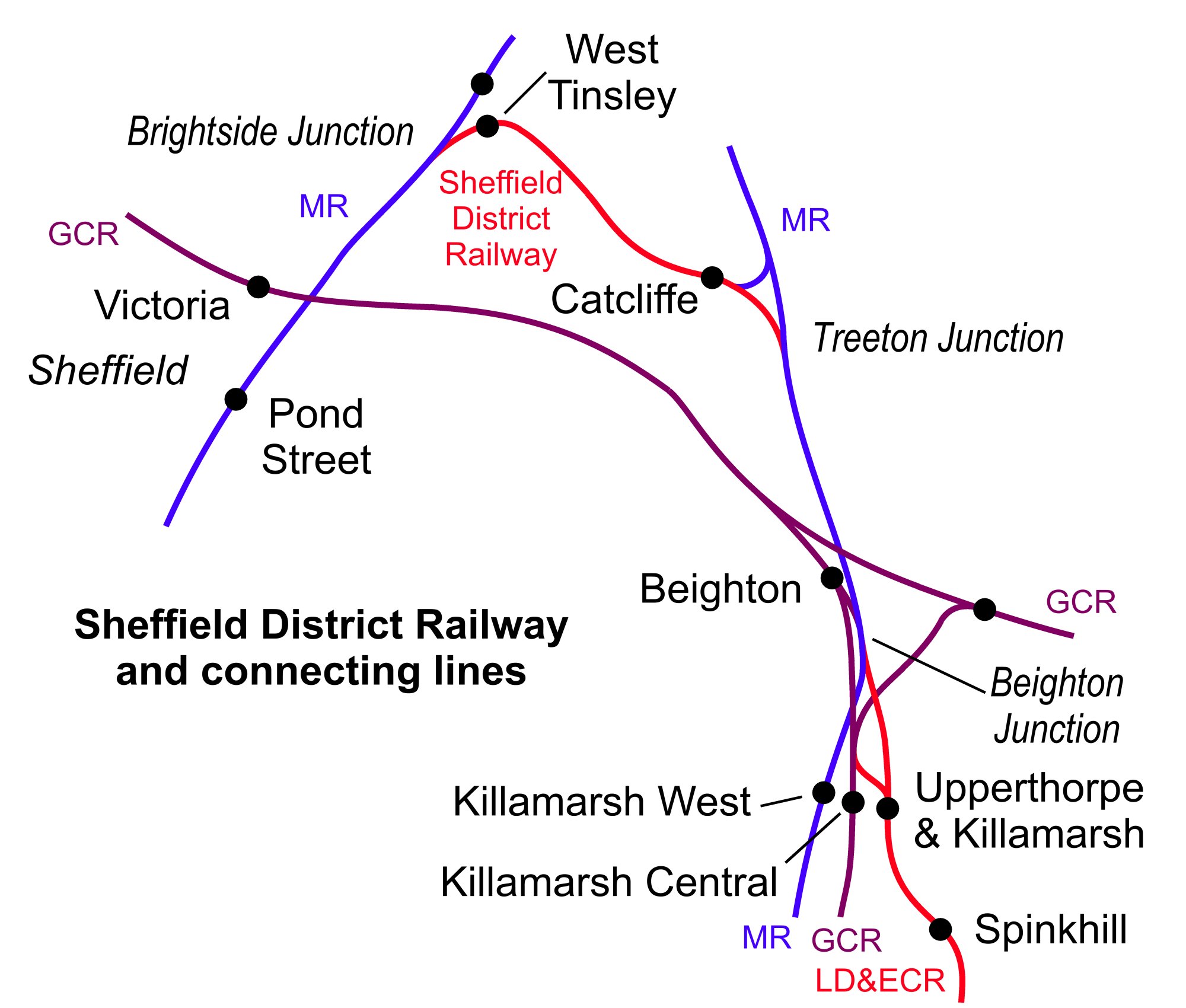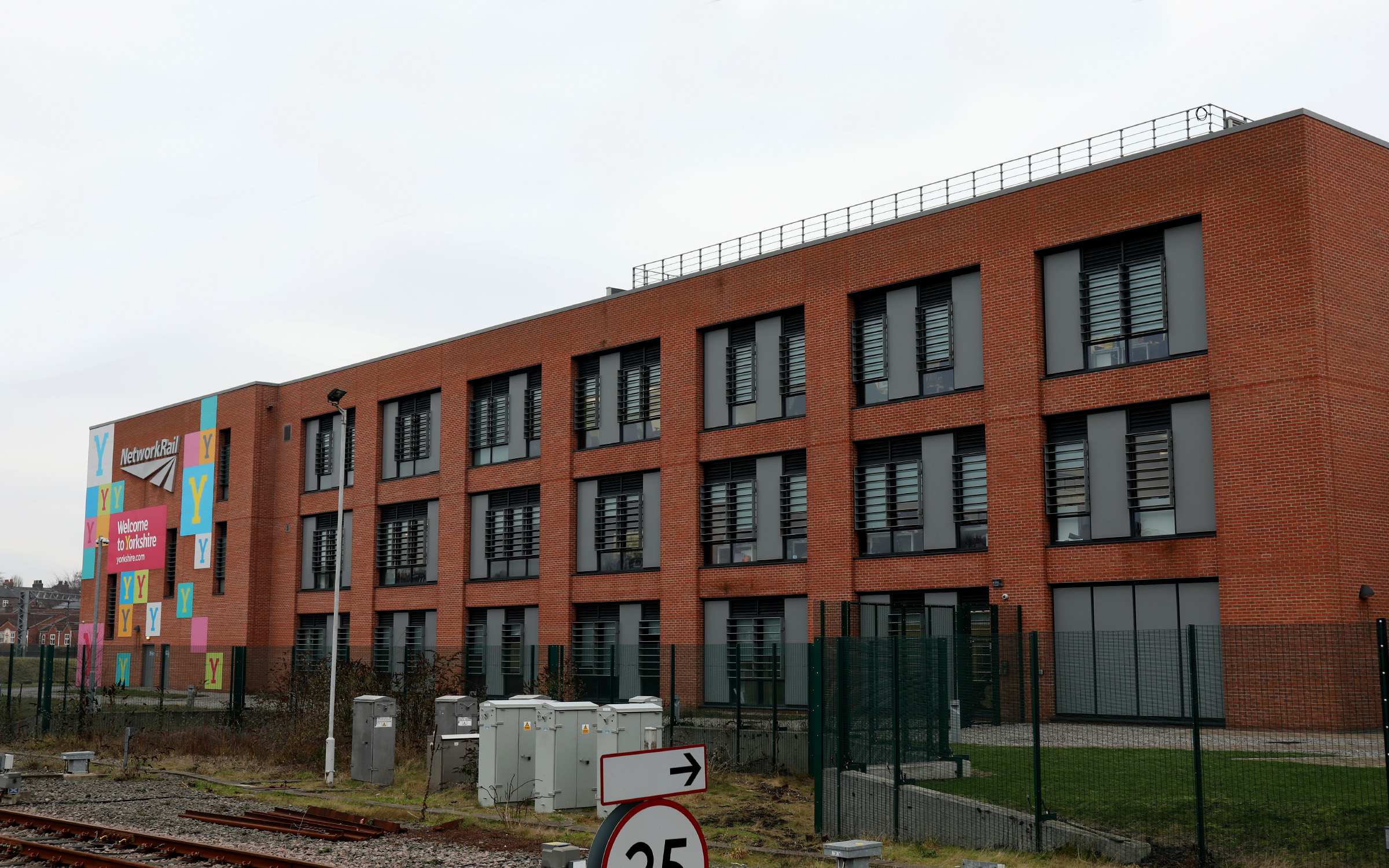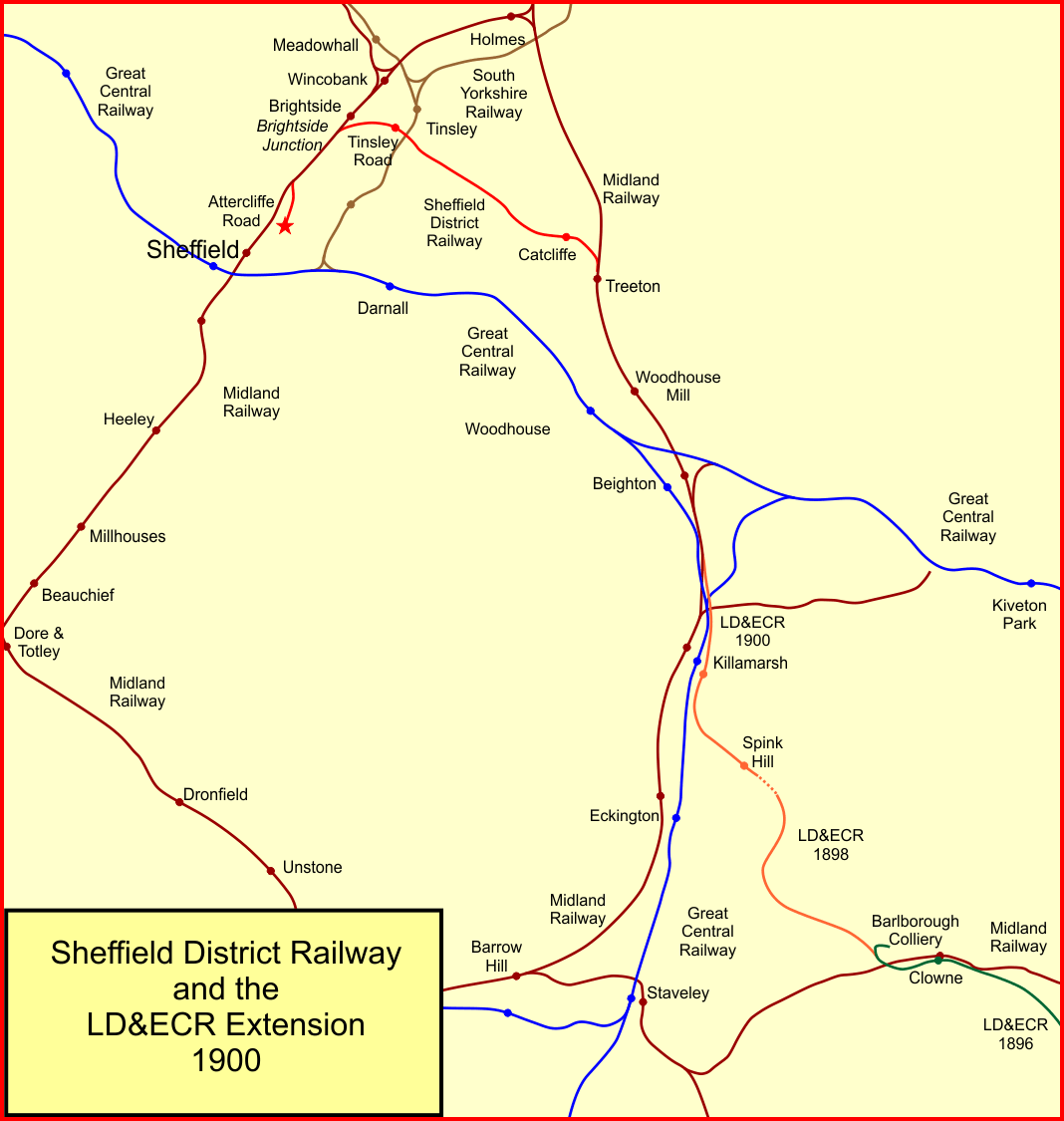|
Beighton Railway Station
Beighton railway station is a former railway station near the village of Beighton on the border between Derbyshire and South Yorkshire, England. Three stations Beighton station existed on three sites at different times: * the first station, believed to have been little more than a halt, was opened by the North Midland Railway when it built its to line, which is now predominantly a freight route. At south of it stood approximately halfway between what is now Beighton Junction and the overbridge which still carries passenger trains east–west between and . This original station was opened when the line opened in June 1840, it was not near to or convenient for the village of Beighton and closed in January 1843. * in 1849 the Manchester, Sheffield and Lincolnshire Railway (MS&LR) completed its Sheffield to Worksop line, which included a branch from just east of to join the North Midland line at what became known as Beighton Junction. They built Beighton's second station a ... [...More Info...] [...Related Items...] OR: [Wikipedia] [Google] [Baidu] |
Beighton, Sheffield
Beighton is a village 6 miles south-east of Sheffield's city centre, now classed as a historic township of the city. Due to much expansion, the village became a part of Sheffield city in 1967, which also saw it transfer from Derbyshire to the newly created South Yorkshire, England. During much of the late 17th to 19th centuries the village was noted for its edge tool manufacturing, with Thomas Staniforth & Co Sickle works being based at nearby Hackenthorpe. The former village features a number of schools, including Beighton Nursery and Infant School and Brook House Junior School. Today, the village has seen much development in terms of housing; however, due to its location on the outskirts of Sheffield, it maintains a rural setting alongside villages including Eckington, Mosborough, Ridgeway, and Dronfield. History The first mention of the village comes from 9th century Anglo Saxon records of Derbyshire land owners. The village was then known as Bectune.The then hamlet sto ... [...More Info...] [...Related Items...] OR: [Wikipedia] [Google] [Baidu] |
British Rail
British Railways (BR), which from 1965 traded as British Rail, was a state-owned company that operated most of the overground rail transport in Great Britain from 1948 to 1997. It was formed from the nationalisation of the Big Four British railway companies, and was privatised in stages between 1994 and 1997. Originally a trading brand of the Railway Executive of the British Transport Commission, it became an independent statutory corporation in January 1963, when it was formally renamed the British Railways Board. The period of nationalisation saw sweeping changes in the railway. A process of dieselisation and electrification took place, and by 1968 steam locomotives had been entirely replaced by diesel and electric traction, except for the Vale of Rheidol Railway (a narrow-gauge tourist line). Passengers replaced freight as the main source of business, and one-third of the network was closed by the Beeching cuts of the 1960s in an effort to reduce rail subsidies. On privatis ... [...More Info...] [...Related Items...] OR: [Wikipedia] [Google] [Baidu] |
Railway Stations In Great Britain Opened In 1893
Rail transport (also known as train transport) is a means of transport that transfers passengers and goods on wheeled vehicles running on rails, which are incorporated in tracks. In contrast to road transport, where the vehicles run on a prepared flat surface, rail vehicles (rolling stock) are directionally guided by the tracks on which they run. Tracks usually consist of steel rails, installed on sleepers (ties) set in ballast, on which the rolling stock, usually fitted with metal wheels, moves. Other variations are also possible, such as "slab track", in which the rails are fastened to a concrete foundation resting on a prepared subsurface. Rolling stock in a rail transport system generally encounters lower frictional resistance than rubber-tyred road vehicles, so passenger and freight cars (carriages and wagons) can be coupled into longer trains. The operation is carried out by a railway company, providing transport between train stations or freight customer facilit ... [...More Info...] [...Related Items...] OR: [Wikipedia] [Google] [Baidu] |
Woodhouse Railway Station
Woodhouse railway station serves Woodhouse and Woodhouse Mill in Sheffield, South Yorkshire, England. The station is east of Sheffield station on the Sheffield to Lincoln Line. The next station east was , until its closure in 1955, and is now . The next station west is . Beighton railway station, originally adjacent to the junction with the Midland Railway, but rebuilt by the MS&LR when it began work on its "Derbyshire Lines", was until 1954 the next station south. Woodhouse Mill, Orgreave and Fence were served by a station on the North Midland Railway named . From 1955 until removal in 1981, the Barnsley Junction-Rotherwood segment of the Manchester – Sheffield – Wath electrification terminated slightly west of the Woodhouse station platforms, within sight of the station. History The present station is the second built to serve the community of Woodhouse, then separate from and not under the governance of Sheffield. The railway line between Sheffield and Gainsborou ... [...More Info...] [...Related Items...] OR: [Wikipedia] [Google] [Baidu] |
Ian Allan Publishing
Ian Allan Publishing was an English publisher, established in 1942, which specialised in transport books. It was founded by Ian Allan. In 1942 Ian Allan, then working in the public relations department for the Southern Railway at Waterloo station, decided he could deal with many of the requests he received about rolling stock by collecting the information into a book. The result was his first book, ''ABC of Southern Locomotives''. This proved to be a success, contributing to the emergence of trainspotting as a popular hobby in the UK, and leading to the formation of the company.Ian Allan…the man who launched a million locospotters ''The Railway Magazine'' issue 1174 February 1999 pages 20-27 The company grew from a small producer of books for train enthusiasts and spotters to a large transport publisher. Each year it published books covering subjects such as military and civil aviation, naval and maritime topics, buses, trams, trolleybuses and steam railways, including hi ... [...More Info...] [...Related Items...] OR: [Wikipedia] [Google] [Baidu] |
York Rail Operating Centre
York Rail Operating Centre (also known as York ROC) is a Rail operating centre (ROC) located at the south western end of railway station in York, England. The site is one of twelve that will control all signalling across the mainland of the United Kingdom. It was opened in stages from 2014 onwards, with responsibility for signalling becoming active in January 2015. The York ROC accepted the role of its predecessor, the adjacent York Integrated Electronic Control Centre (IECC), in December 2018. Of the twelve ROC signalling centres that have been built across the regions for Network Rail, York is the largest and controls the London North Eastern (LNE) region which includes the East Coast Main Line between London King's Cross and the Scottish Borders. History The centre, along with 13 others, was proposed in 2011 in an effort by Network Rail to combine train control, signalling and level crossing operations.Not all level crossings will be transferred by the new system. Whilst ... [...More Info...] [...Related Items...] OR: [Wikipedia] [Google] [Baidu] |
Sheffield District Railway
The Sheffield District Railway was a railway line in South Yorkshire, England. It was built to give the Lancashire, Derbyshire and East Coast Railway access to Sheffield, primarily for goods traffic, for which a large goods depot at Attercliffe, in Sheffield, was built. The construction was sponsored by the LD&ECR and the Great Eastern Railway together, with the support of the Midland Railway, which agreed running powers over sections of its own lines. The Sheffield District Railway opened in 1900. The LD&ECR operated the passenger service, although the Midland Railway later ran passenger trains too. The SDR did not have rolling stock and did not operate trains itself. The LD&ECR was absorbed by the Great Central Railway in 1907, and the GCR inherited the LD&ECR running powers. In the 1960s British Railways sought to rationalise freight operations in the Sheffield area, and needed to build a marshalling yard that had good access to both the former Midland Railway and former Gr ... [...More Info...] [...Related Items...] OR: [Wikipedia] [Google] [Baidu] |
Sheffield Victoria Railway Station
Sheffield Victoria was the main railway station in Sheffield, Yorkshire, England, on the Great Central Railway, between Chesterfield and Penistone. History Early history Engineered by Joseph Locke, the Sheffield, Ashton-under-Lyne and Manchester Railway linking Manchester and Sheffield opened in 1845. Originally, this line terminated at the Bridgehouses station, which was about to the west of the future Victoria station. In 1847, the Sheffield, Ashton-under-Lyne and Manchester Railway merged with two other railway companies to form the Manchester, Sheffield and Lincolnshire Railway. The station at Bridgehouses had been outgrown, so an extension and new station were planned. John Fowler, who later gained fame for co-designing the Forth Railway Bridge in Scotland, was employed to engineer the extension and station. Fowler's design included a viaduct over the Wicker that was high, long and two island platforms long. The extension was completed in 1847–1848 and the new Vic ... [...More Info...] [...Related Items...] OR: [Wikipedia] [Google] [Baidu] |
Shirebrook North Railway Station
Shirebrook North railway station was a railway station serving the town of Shirebrook in Derbyshire, England. It was on the Lancashire, Derbyshire and East Coast Railway running from Chesterfield to Lincoln. The starion was also on the former Shirebrook North to Nottingham Victoria Line and the Sheffield District Railway. The station has since been demolished and housing now occupies parts of the site with some stub rails nearby serving a train scrapper. Ambiguity There have been four separate stations with "Shirebrook" in their names: *Shirebrook North which is the subject of this article * Shirebrook South, * Shirebrook Colliery (later renamed Shirebrook Colliery Sidings) for colliery workmen's trains only, and *Shirebrook station which is on the Robin Hood Line. Shirebrook South, Shirebrook Colliery Sidings and Shirebrook North have been closed for many years. Shirebrook West closed in 1964 but reopened in 1998 as plain "Shirebrook". Shirebrook ''West'' was actually on ... [...More Info...] [...Related Items...] OR: [Wikipedia] [Google] [Baidu] |
Lancashire, Derbyshire And East Coast Railway
The Lancashire, Derbyshire and East Coast Railway (LD&ECR) was built to connect coalfields in Derbyshire and Nottinghamshire with Warrington and a new port on the Lincolnshire coast. It was a huge undertaking, and the company was unable to raise the money to build its line. With the financial help of the Great Eastern Railway it managed to open between Chesterfield and Lincoln with a branch towards Sheffield from 1896. Despite efforts to promote tourist travel, the passenger business was never buoyant, but collieries were connected to the line, at first and in succeeding years. The Great Eastern Railway, and other main line companies, transported coal to the southern counties, and the company's engines took coal to Immingham in great quantities. The company had a fleet of tank engines. The Sheffield branch was not completed, but interests in Sheffield encouraged its extension which was built by a nominally independent company, the Sheffield District Railway, sponsored by the LD&E ... [...More Info...] [...Related Items...] OR: [Wikipedia] [Google] [Baidu] |
Beighton Junction 2 Geograph-2149224
Beighton may refer to: People * Graham Beighton (born 1939), English footballer * Henry Beighton (1687–1743), English engineer and surveyor * Nick Beighton (born 1981), British paracanoeist * Peter Beighton (born 1934), British geneticist * Sean Beighton (born 1988), American curler * Thomas Beighton (1790–1844), English missionary Fictional characters * Miss Beighton, a character in Kipling's short story '' Cupid's Arrows'' Places * Beighton, Norfolk, England * Beighton, South Yorkshire, Sheffield, England **Beighton railway station (closed 1954) ** Beighton Junction, a series of railway junctions **Beighton (ward), the ward within Sheffield * Beighton Fields, Derbyshire, England Other uses * Beighton Cup Beighton Cup is a field hockey tournament organized by Hockey Bengal (formerly the Bengal Hockey Association). Instituted in 1895, it is one of the oldest field hockey tournaments in the world and is held every year at Kolkata. History Aristocr ..., a field hockey ... [...More Info...] [...Related Items...] OR: [Wikipedia] [Google] [Baidu] |


.jpg)





